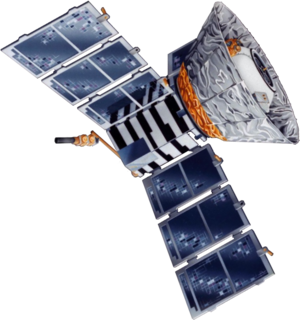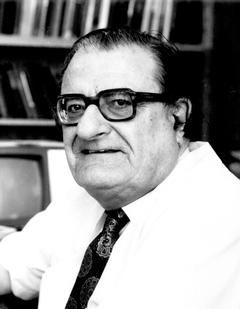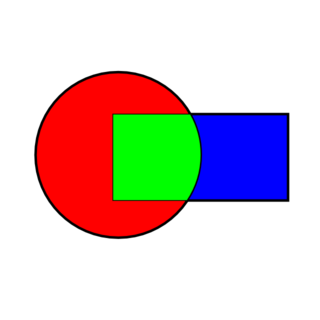Related Research Articles

Sir John Anthony Pople was a British theoretical chemist who was awarded the Nobel Prize in Chemistry with Walter Kohn in 1998 for his development of computational methods in quantum chemistry.

The Cosmic Background Explorer, also referred to as Explorer 66, was a NASA satellite dedicated to cosmology, which operated from 1989 to 1993. Its goals were to investigate the cosmic microwave background radiation of the universe and provide measurements that would help shape our understanding of the cosmos.
Gaussian is a general purpose computational chemistry software package initially released in 1970 by John Pople and his research group at Carnegie Mellon University as Gaussian 70. It has been continuously updated since then. The name originates from Pople's use of Gaussian orbitals to speed up molecular electronic structure calculations as opposed to using Slater-type orbitals, a choice made to improve performance on the limited computing capacities of then-current computer hardware for Hartree–Fock calculations. The current version of the program is Gaussian 16. Originally available through the Quantum Chemistry Program Exchange, it was later licensed out of Carnegie Mellon University, and since 1987 has been developed and licensed by Gaussian, Inc.
Numerical methods for partial differential equations is the branch of numerical analysis that studies the numerical solution of partial differential equations (PDEs).
MOPAC is a popular computer program used in computational chemistry. It is designed to implement semi-empirical quantum chemistry algorithms, and it runs on Windows, Mac, and Linux.
MNDO, or Modified Neglect of Diatomic Overlap is a semi-empirical method for the quantum calculation of molecular electronic structure in computational chemistry. It is based on the Neglect of Diatomic Differential Overlap integral approximation. Similarly, this method replaced the earlier MINDO method. It is part of the MOPAC program and was developed in the group of Michael Dewar. It is also part of the AMPAC, GAMESS (US), PC GAMESS, GAMESS (UK), Gaussian, ORCA and CP2K programs.
Austin Model 1, or AM1, is a semi-empirical method for the quantum calculation of molecular electronic structure in computational chemistry. It is based on the Neglect of Differential Diatomic Overlap integral approximation. Specifically, it is a generalization of the modified neglect of differential diatomic overlap approximation. Related methods are PM3 and the older MINDO.

PM3, or Parametric Method 3, is a semi-empirical method for the quantum calculation of molecular electronic structure in computational chemistry. It is based on the Neglect of Differential Diatomic Overlap integral approximation.
CNDO is the abbreviation for Complete Neglect of Differential Overlap, one of the first semi empirical methods in quantum chemistry. It uses two approximations:

Michael James Steuart Dewar was an American theoretical chemist.
INDO stands for Intermediate Neglect of Differential Overlap. It is a semi-empirical quantum chemistry method that is a development of the complete neglect of differential overlap (CNDO/2) method introduced by John Pople. Like CNDO/2 it uses zero-differential overlap for the two-electron integrals but not for integrals that are over orbitals centered on the same atom.
ZINDO is a semi-empirical quantum chemistry method used in computational chemistry. It is a development of the INDO method. It stands for Zerner's Intermediate Neglect of Differential Overlap, as it was developed by Michael Zerner and his coworkers in the 1970s. Unlike INDO, which was really restricted to organic molecules and those containing the atoms B to F, ZINDO covers a wide range of the periodic table, even including the rare-earth elements. There are two distinct versions of the method:
In computational chemistry, NDDO is a formalism that was first introduced by John Pople and it is now the basis of most successful semiempirical methods. While INDO added all one-centre two electron integrals to the CNDO/2 formalism, NDDO adds all two centre integrals for repulsion between a charge distribution on one centre and a charge distribution on another centre. Otherwise the zero-differential overlap approximation is used.
AMPAC is a general-purpose semiempirical quantum chemistry program. It is marketed by Semichem, Inc. and was developed originally by Michael Dewar and his group.
Zero differential overlap is an approximation in computational molecular orbital theory that is the central technique of semi-empirical methods in quantum chemistry. When computers were first used to calculate bonding in molecules, it was only possible to calculate diatomic molecules. As computers advanced, it became possible to study larger molecules, but the use of this approximation has always allowed the study of even larger molecules. Currently semi-empirical methods can be applied to molecules as large as whole proteins. The approximation involves ignoring certain integrals, usually two-electron repulsion integrals. If the number of orbitals used in the calculation is N, the number of two-electron repulsion integrals scales as N4. After the approximation is applied the number of such integrals scales as N2, a much smaller number, simplifying the calculation.
Semi-empirical quantum chemistry methods are based on the Hartree–Fock formalism, but make many approximations and obtain some parameters from empirical data. They are very important in computational chemistry for treating large molecules where the full Hartree–Fock method without the approximations is too expensive. The use of empirical parameters appears to allow some inclusion of electron correlation effects into the methods.
Indo may refer to:

In mathematics, numerical analysis, and numerical partial differential equations, domain decomposition methods solve a boundary value problem by splitting it into smaller boundary value problems on subdomains and iterating to coordinate the solution between adjacent subdomains. A coarse problem with one or few unknowns per subdomain is used to further coordinate the solution between the subdomains globally. The problems on the subdomains are independent, which makes domain decomposition methods suitable for parallel computing. Domain decomposition methods are typically used as preconditioners for Krylov space iterative methods, such as the conjugate gradient method, GMRES, and LOBPCG.
SAM1, or "Semiempirical ab initio Model 1", is a semiempirical quantum chemistry method for computing molecular properties. It is an implementation the general Neglect of Differential Diatomic Overlap (NDDO) integral approximation, and is efficient and accurate. Related methods are AM1, PM3 and the older MNDO.
In organic chemistry, the Cornforth rearrangement is a rearrangement reaction of a 4-acyloxazole in which the group attached to an acyl on position 4 and the substituent on position 5 of an oxazole ring exchange places. It was first reported in 1949, and is named for John Cornforth. The reaction is used in the synthesis of amino acids, where the corresponding oxazoles occur as intermediates.
References
- Bingham, Richard C.; Dewar, Michael J. S.; Lo, Donald H. (1975). "Ground states of molecules. XXV. MINDO/3. Improved version of the MINDO semiempirical SCF-MO method". Journal of the American Chemical Society. 97 (6): 1285. doi:10.1021/ja00839a001.